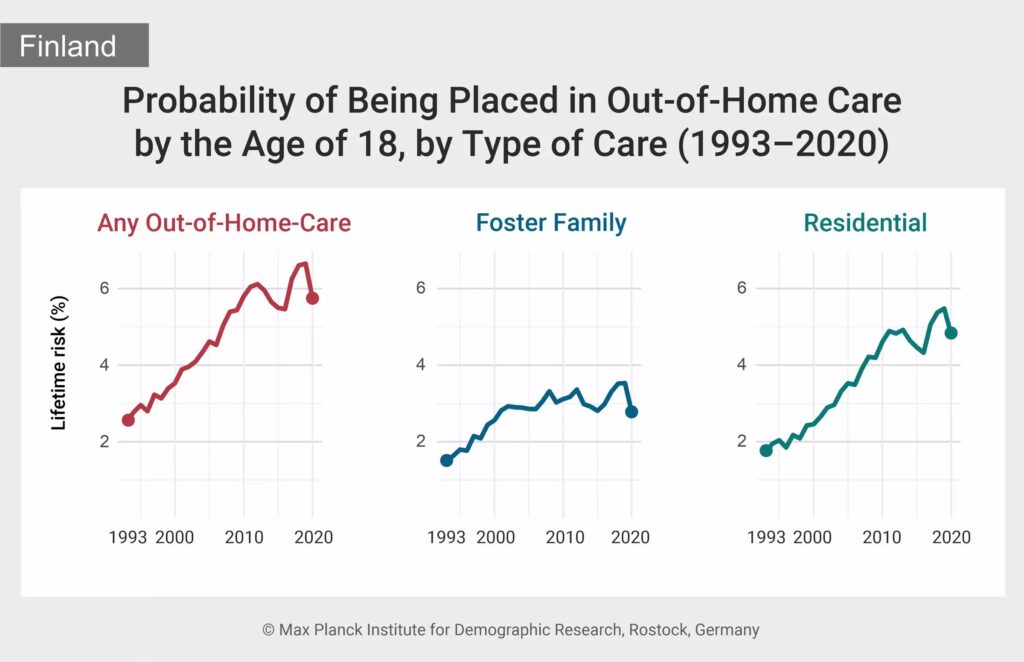
Out-of-home care for children in Finland has seen a dramatic increase, doubling since 1993, according to a recent study by researchers at the Max Planck Institute for Demographic Research (MPIDR) and the University of Helsinki. The study, published in the journal Child Abuse & Neglect, highlights significant changes in child welfare interventions over nearly three decades.
Out-of-home care, considered a last resort in child welfare, involves removing a child from their home to ensure their safety and well-being. This intervention is typically triggered by complex factors such as abuse, neglect, or mental health issues affecting either the parents or the children. The study’s findings reveal that approximately 6% of Finnish children are expected to experience at least one out-of-home care episode during their childhood, a marked increase from previous decades.
New Metrics Provide a Nuanced View of Child Welfare
The research team, led by Aapo Hiilamo and Mikko Myrskylä, utilized demographic methods to offer a more comprehensive understanding of out-of-home care at the population level. Traditional metrics often focus on the number of children in care at a specific time, but the researchers aimed to address the limitations of these measures.
“Trends in out-of-home care are usually monitored by counting the number of children living outside their parents’ home at a given point in time. However, these metrics can be misleading because they don’t account for differences in age structure or important aspects such as the duration or stability of care, or the possibility of family reunification,” explains Hiilamo, the study’s lead author.
The study tracked the daily living arrangements of all children in Finland from 1993 to 2020, calculating probabilities of entering and exiting out-of-home care by age and year. This approach provided insights into the expected duration of care and the likelihood of family reunification.
Rising Trends and Implications
The findings indicate that while the risk of placement has increased, the expected duration of care has decreased from 4.2 years in the early 1990s to 3.5 years in 2020. Additionally, the probability of a sustained return to home by age 18 has improved from 32% to 44%.
“The rise in out-of-home care in general and in residential care in particular is both concerning and puzzling. Known risk factors, such as juvenile delinquency and alcohol consumption, have not changed in parallel, and similar trends are not seen across other Nordic countries. Further research is needed to understand why Finland has such high rates of out-of-home placements,” explains Hiilamo.
Exploring the Broader Context
This development in Finland’s child welfare system raises important questions about the underlying causes. While the study identifies a significant shift towards residential care, the reasons for this trend are not immediately clear. The lack of similar patterns in other Nordic countries suggests unique national factors at play.
Experts suggest that socio-economic changes, policy shifts, or cultural factors might contribute to the rising trends. The Finnish government has historically prioritized child welfare, but the doubling of out-of-home care rates indicates potential gaps in early intervention and support systems.
Demographic Methods Offer New Insights
The multistate models employed in the study offer a valuable tool for child welfare research, providing a framework that can be adapted for use in other countries. These models can help explore transitions between different stages of child welfare services and assess the effectiveness of interventions.
“Demographic research often focused on older populations due to aging societies, but these methods are equally valuable to studying children and youth. Demographic tools help quantify differences in child and youth welfare services across time and space, and thanks to new software developed at the MPIDR, these tools are now more accessible,” concludes Hiilamo.
Looking Ahead
As Finland grapples with the implications of these findings, the study underscores the need for ongoing research and policy evaluation. Understanding the factors driving the increase in out-of-home care is crucial for developing effective strategies to support vulnerable children and their families.
The research team plans to extend their analysis to explore the impact of various interventions and policy changes over time. By leveraging demographic methods, they aim to provide policymakers with data-driven insights to enhance child welfare systems both in Finland and globally.







